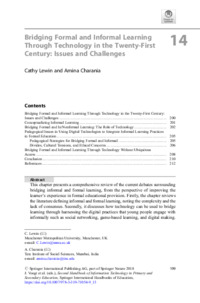Bridging Formal and Informal Learning Through Technology in the Twenty-First Century: Issues and ChallengesCathy Lewin, Amina Charania
Zu finden in: Second Handbook of Information Technology in Primary and Secondary Education (Seite 199 bis 215), 2018
  |
 |
 Diese Seite wurde seit 2 Jahren inhaltlich nicht mehr aktualisiert.
Unter Umständen ist sie nicht mehr aktuell.
Diese Seite wurde seit 2 Jahren inhaltlich nicht mehr aktualisiert.
Unter Umständen ist sie nicht mehr aktuell.
 Zusammenfassungen
Zusammenfassungen
 This chapter presents a comprehensive review of the current debates surrounding bridging informal and formal learning, from the perspective of improving the learner’s experience in formal educational provision. Firstly, the chapter reviews the literature defining informal and formal learning, noting the complexity and the lack of consensus. Secondly, it discusses how technology can be used to bridge learning through harnessing the digital practices that young people engage with informally such as social networking, game-based learning, and digital making. The authors then outline some pedagogical issues which need to be considered to maximize the potential of bridging formal and informal learning. Next, the pedagogical strategies needed to enhance learners’ opportunities for autonomy, collaboration, and authentic learning are discussed. The chapter also explores the divides, cultural tensions, and ethical concerns that shape practices such as the constraints of a performativity culture and the invasion of young people’s private space. A vignette of a project in India is presented as an illustration of good practice. Here, despite limited access to technology, young people have been supported to engage in authentic learning projects involving the creation of digital artifacts, both in- and out-of-school. The chapter concludes by arguing that there must be a shift from transmissive to collaborative pedagogical strategies; school cultures need to change. In order to do so, teachers need professional development and support to take risks and experiment. More research is needed so that the interrelationship between technology-enabled formal and informal learning can be better understood but also because good models of practice need to be identified and shared.
This chapter presents a comprehensive review of the current debates surrounding bridging informal and formal learning, from the perspective of improving the learner’s experience in formal educational provision. Firstly, the chapter reviews the literature defining informal and formal learning, noting the complexity and the lack of consensus. Secondly, it discusses how technology can be used to bridge learning through harnessing the digital practices that young people engage with informally such as social networking, game-based learning, and digital making. The authors then outline some pedagogical issues which need to be considered to maximize the potential of bridging formal and informal learning. Next, the pedagogical strategies needed to enhance learners’ opportunities for autonomy, collaboration, and authentic learning are discussed. The chapter also explores the divides, cultural tensions, and ethical concerns that shape practices such as the constraints of a performativity culture and the invasion of young people’s private space. A vignette of a project in India is presented as an illustration of good practice. Here, despite limited access to technology, young people have been supported to engage in authentic learning projects involving the creation of digital artifacts, both in- and out-of-school. The chapter concludes by arguing that there must be a shift from transmissive to collaborative pedagogical strategies; school cultures need to change. In order to do so, teachers need professional development and support to take risks and experiment. More research is needed so that the interrelationship between technology-enabled formal and informal learning can be better understood but also because good models of practice need to be identified and shared. Dieses Kapitel erwähnt ...
Dieses Kapitel erwähnt ...
 Personen KB IB clear | N. Balacheff , Tom Brown , Tak-Wai Chan , J. Cherniavsky , Jay Cross , Pierre Dillenbourg , Ola Erstad , Heinz Ulrich Hoppe , S. Hsi , Kinshuk , C. Looi , Richard E. Mayer , M. Milrad , Cathleen Norris , Charles Patton , Roy Pea , Jeremy Roschelle , Marlene Scardamalia , Julian Sefton-Green , Mike Sharples , Elliot Soloway | |||||||||||||||||||||||||||||||||||||||||||||
 Begriffe KB IB clear | formal learningformal learning
, game-based learninggame-based learning
, informal learninginformal learning
,  work-life-balance work-life-balance
| |||||||||||||||||||||||||||||||||||||||||||||
 Bücher |
| |||||||||||||||||||||||||||||||||||||||||||||
 Texte |
|
 Tagcloud
Tagcloud
 Zitationsgraph
Zitationsgraph
 Zitationsgraph (Beta-Test mit vis.js)
Zitationsgraph (Beta-Test mit vis.js)
 Anderswo finden
Anderswo finden
 Volltext dieses Dokuments
Volltext dieses Dokuments
 |  Bridging Formal and Informal Learning Through Technology in the Twenty-First Century: Issues and Challenges: Artikel als Volltext bei Springerlink ( Bridging Formal and Informal Learning Through Technology in the Twenty-First Century: Issues and Challenges: Artikel als Volltext bei Springerlink ( : :  , 314 kByte; , 314 kByte;  : :  ) ) |
 Anderswo suchen
Anderswo suchen 
 Beat und dieses Kapitel
Beat und dieses Kapitel
Beat hat Dieses Kapitel während seiner Zeit am Institut für Medien und Schule (IMS) ins Biblionetz aufgenommen. Beat besitzt kein physisches, aber ein digitales Exemplar. Eine digitale Version ist auf dem Internet verfügbar (s.o.). Aufgrund der wenigen Einträge im Biblionetz scheint er es nicht wirklich gelesen zu haben. Es gibt bisher auch nur wenige Objekte im Biblionetz, die dieses Werk zitieren.















 Biblionetz-History
Biblionetz-History